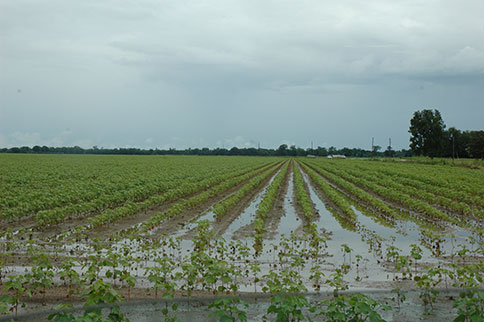
Singer Steve Earle notes in “The Rain Came Down,” that heavenly precipitation “will wash you away, or it ain’t never enough.” That’s the position in which Escambia County farmers, along with most farmers in southern and central Alabama, now find themselves.
Still reeling from the effects of last year’s prolonged drought that brought a federal disaster declaration, those who earn their living from the land are now awaiting the issuance of another declaration, this one the result of prolonged rainfall that has left them unable to harvest mature summer crops or plant crops for the anticipated fall harvest.
The crisis evolved from already heavy May and June rains that were enhanced by the season’s first major storm to affect the Gulf Coast. Tropical Storm Cindy dumped from four inches to more than a foot of additional water on the area’s already saturated farmlands, barring access to fields and drowning or souring corn, cotton, peanuts, soybeans and most vegetable crops that were still in the field.
John McMillan, Alabama Commissioner of Agriculture and Industries, noted in a recent interview that the unusually heavy rainfall totals over the past 45-60 days have placed “a tremendous burden” on Alabama farmers.
“The potential adverse impact from Tropical Storm Cindy will likely ruin crops that are already planted while at the same time create conditions where other crops cannot be planted and harvested in a timely fashion,” said the state’s top agricultural official.
McMillan and other agricultural officials are working with Gov. Kay Ivey’s office and the Alabama Farmers Federation to secure a federal disaster declaration. If and when such a declaration is issued, officials from the United States Department of Agriculture’s Farm Service Agency will begin to visit farms in the affected areas and formally assess the damage.
“FSA is currently estimating the damages in all counties in Alabama as a result of excessive rainfall that has occurred since May,” said Acting FSA State Director Jacqueline McCloud in an emailed statement. “In some instances, damage assessments can’t be completed as some fields are saturated and not accessible to vehicles or personnel at the moment.”
McCloud said several options are open to farmers who suffer rain-related losses, including cost-share assistance through the USDA’s Emergency Conservation Program or emergency loans.
Jimmy McElhaney, a Bratt, Fla. farmer who also raises cotton on land near Robinsonville, called the past month “the worst June I’ve ever seen, as far as rain.” He said the damage to this year’s crops is non-reversible, and the inability to plant fall crops lessens the chance of recovery.
“The damage has been done, and we can’t recover,” he said. “Most of the crops in the fields – cotton, corn, peanuts, soybeans, all of them – have drowned or have started to rot. Tomatoes and vegetables have been hurt, too. We already had a wet May, then all this June rain …”
But, he said, he wouldn’t fret too openly about the abundance of rain.
“I hate to fuss about the rain, because when it dries out, we’ll wonder where it is,” he said. “It’s just a case of God’s will be done; there’s nothing we can do about it.”
McMillan agreed that the preponderance of precipitation has created short-term and long-term financial hardships for farmers, something that might escape the notice of most non-farmers.
“Many Alabamians might not realize the magnitude this kind of disaster event has on agriculture,” he said. “Aside from creating a less than profitable growing season, this situation only adds to the already depressed prices for agriculture commodities. The effect of this event will result in an economic loss for rural Alabama. Our farmers will feel the impact of this storm into this fall and winter.”
